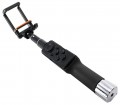Minimum length
The length of the monopod when folded. First of all, ease of transportation depends on this parameter, although a fully folded design can also be used when shooting. It is also worth mentioning that a smaller folded length (for the same maximum length) can mean more sections, which complicates the design, increases its cost and somewhat reduces reliability.
The most compact modern selfie sticks when folded take
less than 15 cm, the largest ones can have a minimum length of
more than 30 cm(this is an inevitable consequence of the large overall length).
Maximum length
The longest length that the monopod can be extended to.
Longer length allows you to place the camera further away from the user and fit more space into the frame. It can also be useful when shooting in hard-to-reach places where you can’t just reach with your hand. Also, with the same minimum length, a larger maximum length means a wider range of distances available for a given tripod. On the other hand, the working size of the structure significantly affects its weight and price.
If we talk about specific numbers, then the shortest modern selfie sticks are up
to 50 cm long. A value of
51 – 75 cm is considered average,
76 – 100 cm is more than average, and in the longest models they can expand to
1 m or more.
Number of sections
The number of separate sliding sections provided in the design of the tripod.
The more sections, with the same length, the shorter each individual section will be and the more compact the tripod will be when folded. On the other hand, an increase in the number of individual parts adversely affects the strength and reliability of the structure. When choosing the number of sections, manufacturers proceed from a compromise between these points; so long tripods tend to have more sections to keep them compact when folded.
It is also worth mentioning that in addition to multi-section
sliding selfie sticks,
fixed models are also produced, consisting of only one section. They are intended not so much for selfies, but for general convenience when shooting on a smartphone or action camera.
Maximum load
Of course, you also need to take into account the weight of the case, box and other accessories installed on the gadget.
Most modern selfie tripods have a load capacity
of up to 0.5 kg, which seems modest, but for most smartphones and action cameras, more is not required.
0.5 – 1 kg is the average value, it is found mainly in models with the ability to install action cameras. Note that such a margin of safety already allows (with the necessary mounts) the use of classic cameras — compacts, many "mirrorless" and even some "reflex cameras" with relatively modest optics. And the most durable models can withstand more than more
than 1 kg ; this design can be useful both for a massive device and for a relatively light gadget — if you need a maximum margin of safety.
Material
The main material used in the construction of the tripod, more precisely, the tripod rods (other materials can be used for the handle and head, for example, a plastic or leather overlay on a metal rod).
—
Metal. The metal found in selfie tripods can have different compositions and properties: for example, steel costs relatively little but is heavy, aluminium is light but expensive, and so on. Anyway, the advantage of this option over plastic is its high strength, which allows you to create structures for almost any camera weight (up to several kilograms).
—
Plastic. Inexpensive and fairly light material, plastic has fairly good strength, but is noticeably inferior to metals in terms of reliability. Therefore, this option is somewhat less common, mainly in tripods with a small maximum load.

